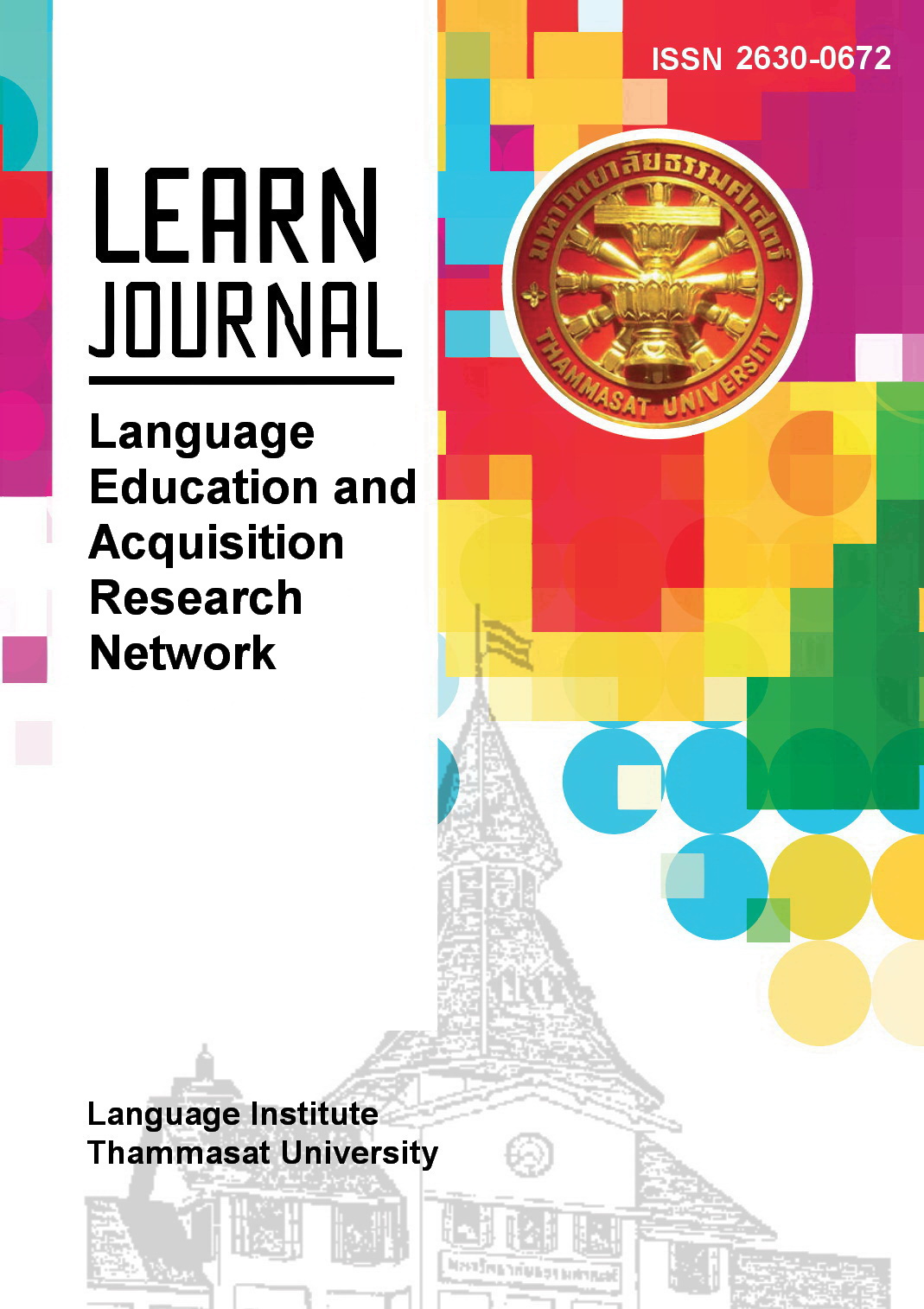A Comparison of ‘little’ and ‘small’ in English and Thai: A Corpus-Based Study
Main Article Content
Abstract
This paper studies the two English synonymous words little and small, and their Thai equivalents nᴐːj4 and lek4. In addition to monolingual and bilingual dictionaries, British National Corpus, Thai National Corpus and an English-Thai parallel corpus were used in this study. It is found that little and small and their Thai equivalents are not precisely identical in meaning. In addition, there are some meanings that can apply to all these four English-Thai synonymous words. Therefore, a Thai learner of English may not be able to simply equate the use of little and small with nᴐːj4 and lek4, and vice versa. Moreover, it is also found that little and small can be translated into Thai with some other words rather than nᴐːj4 and lek4. This indicates the complexity of meaning in which little and small can connect to other related meanings and be translated into Thai with other words. This study suggests that information provided in dictionaries alone is not sufficient. Learners should learn how to use corpora as a resource to enhance their lexical knowledge in both languages.
Article Details
References
Aroonmanakun, V. (2015). Quick or fast: A corpus-based study of English synonyms. LEARN Journal, 8(1), 53-62.
Aroonmanakun, W., Tansiri, K., & Nittayanuparp, P. (2009). Thai national corpus: A progress report. Proceedings of the 7th Workshop on Asian Language Resources (ALR7), 153–160. Suntec, Singapore.
Biber, D., Conrad, S., & Reppen, R. (1996). Corpus-based investigation of language use. Annual Review of Applied Linguistics, 16, 114-136.
Booij, G. E. (2007). The grammar of words: An introduction to linguistic morphology. Oxford University Press.
Corpora: BNC. English. (n.d.). Retrieved January 16, 2022, from https://www.english-corpora.org/bnc/
Hardie, A. (2014, April 28). Log ratio – An informal introduction. ESRC Centre for Corpus Approaches to Social Science (CASS). Retrieved January 16, 2022, from http://cass.lancs.ac.uk/log-ratio-an-informal-introduction/
Hong, JF. (2014). Chinese near-synonym study based on the Chinese gigaword corpus and the Chinese learner corpus. In Su, X., He, T. (Eds), Chinese Lexical Semantics. CLSW 2014. Lecture Notes in Computer Science, vol 8922. Springer, Cham. https://doi.org/10.1007/978-3-319-14331-6_33
Hutto, C. J., & Gilbert, E. (2014). VADER: A parsimonious rule-based model for sentiment analysis of social media text. Paper presented at the ICWSM.
Lau, H. Y. P., & Lee, S. Y. M. (2016). A corpus-based study on near-synonymous manner adverbs: “yiran” and “duanran”. In Dong, M., Lin, J., Tang, X. (Eds), Chinese Lexical Semantics. CLSW 2016. Lecture Notes in Computer Science, vol 10085. Springer, Cham. https://doi.org/10.1007/978-3-319-49508-8_57
Lin, Y.-Y., & Chung, S.-F. (2021). A corpus-based study on two near-synonymous verbs in academic journals: PROPOSE and SUGGEST. English Teaching & Learning, 45(2), 189–216.
Mallikamas, P., Chakrabongse, N., & Piammattawat, P. (2010). Oxford-River books English-Thai dictionary. Oxford University Press.
Oh, S.-Y. (2000). Actually and in fact in American English: a data-based analysis. English Language and Linguistics, 4, 243 - 268.
Pearson Education Limited. (n.d.). Longman dictionary of contemporary English online. Retrieved October 9, 2022, from https://www.ldoceonline.com/
Pérez-Paredes, P., & Bueno-Alastuey, M. C. (2019). A corpus-driven analysis of certainty stance adverbs: Obviously, really and actually in spoken native and learner English. Journal of Pragmatics, 140, 22-32.
Phoocharoensil, S. (2021). Semantic prosody and collocation: A corpus study of the near-synonyms persist and persevere. Eurasian Journal of Applied Linguistics, 7(1), 240-258
Royal Institute Dictionary. (2011). Nanmeebooks. (in Thai)
Vongvipanond, P. (1985). Lexicological significance of semantic doublets in Thai. The 18th International Conference on Sino-Tibetan Language and Linguistics, August 27-29, 1985, Bangkok, Thailand.


